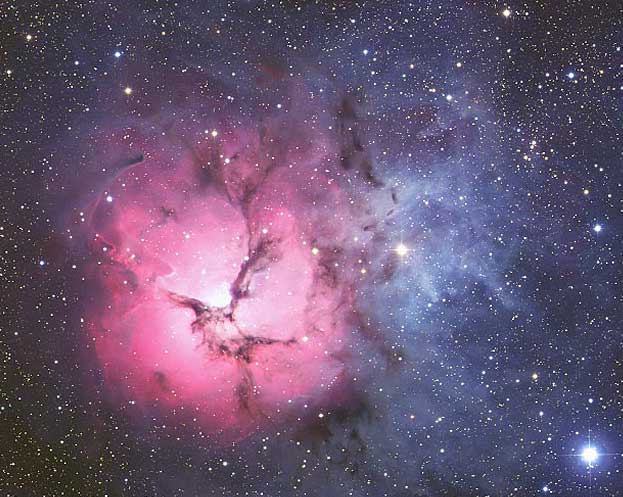Credit & Copyright: Anglo-Australian Observatory, Photograph by
David Malin
Explanation:
Unspeakable beauty and unimaginable bedlam can be found
together in the
Trifid Nebula.
Also known as M20,
this photogenic nebula is visible
with good binoculars towards the constellation of Sagittarius.
The energetic processes of
star formation create not
only the colors but the
chaos.
The
red-glowing gas
results from high-energy starlight striking interstellar
hydrogen gas.
The dark
dust
filaments that lace
M20 were created in
the atmospheres of cool
giant stars and in the
debris from
supernovae explosions.
Which bright young stars light up the blue
reflection nebula is still
being investigated.
The light from
M20 we see today left perhaps 3000 years ago,
although the exact distance remains unknown.
Light takes about 50 years to cross
M20.
1999 2000 2001 2002 2003 2004 2005 2006 2007 2008 2009 2010 2011 2012 2013 2014 2015 2016 2017 2018 2019 2020 2021 2022 2023 2024 2025 |
Yanvar' Fevral' Mart Aprel' Mai Iyun' Iyul' Avgust Sentyabr' Oktyabr' Noyabr' Dekabr' |
NASA Web Site Statements, Warnings, and Disclaimers
NASA Official: Jay Norris. Specific rights apply.
A service of: LHEA at NASA / GSFC
& Michigan Tech. U.
|
Publikacii s klyuchevymi slovami:
Trifid nebula - M 20 - emission nebula - reflection nebula - Trehrazdel'naya tumannost' - emissionnaya tumannost' - otrazhatel'nye tumannosti
Publikacii so slovami: Trifid nebula - M 20 - emission nebula - reflection nebula - Trehrazdel'naya tumannost' - emissionnaya tumannost' - otrazhatel'nye tumannosti | |
Sm. takzhe:
Vse publikacii na tu zhe temu >> | |
